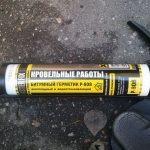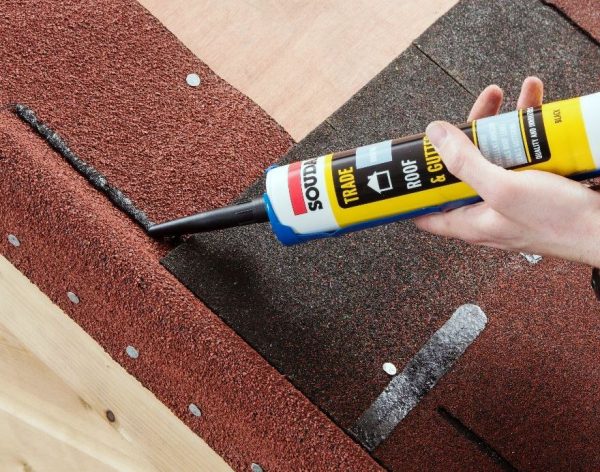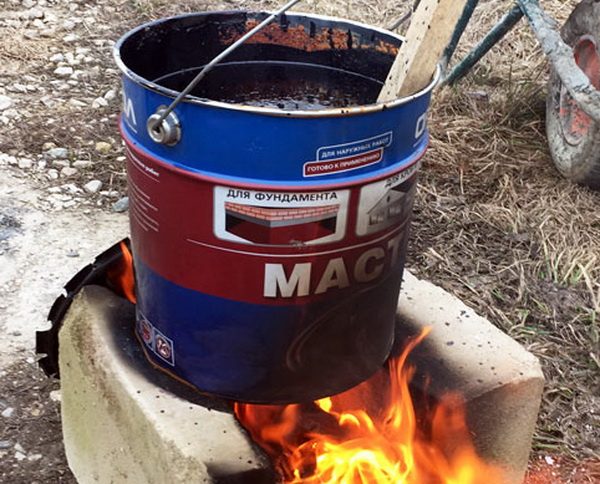The tightness of structures often determines the period of their possible operation. If water gets inside, the destruction of building materials will occur quite soon. Particularly good protection is required on the roof and foundation of the house, because they are constantly in contact with moisture.
- The main properties of bitumen sealants
- Types of bituminous sealants in composition
- High strength bitumen and mineral sealants
- Bitumen-polymer heat-resistant sealants
- Bitumen-rubber sealants: good frost resistance
- Metallic pigment bitumen sealants
- Application of bitumen sealant
- Where can I use bitumen sealant?
- Overview of popular bitumen sealants
- The use of sealants in roofing
- Waterproofing tapes and gels - elimination of leaks
- Application of mastics for overhaul
- Hot Sealant Application Method

To prevent unpleasant consequences, bitumen sealant is used - a tool based on natural bitumen, which has high hydrophobic qualities.
The main properties of bitumen sealants
A person noted the positive characteristics of bitumen and its suitability for household needs several tens of thousands of years ago: for example, Sumerian builders used it to seal buildings. Previously, it was difficult to use, but nowadays the introduction of special polymer additives has greatly facilitated this task. From the end of the 20th century, bituminous sealants began to be produced, which include a tarry oil derivative - bitumen, as well as various improvers, modifiers, plasticizers.
Thanks to polymers, the viscosity characteristics of bitumen have changed, as well as its other properties, so modern sealants boast:
- excellent adhesion to all building materials;
- frost resistance, biostability;
- the ability to withstand heat and temperature extremes;
- strength and elasticity;
- protection of metals from corrosion;
- lack of cracks after drying;
- resistance to UV rays;
- lack of harmful components, safety for humans.
Due to these properties, sealants are very widely used in construction, repair at various stages of work.
to contents ↑Types of bituminous sealants in composition
The first sealants were those containing bitumen and rubber. Now many species have been enriched with various additives. There are three main groups of sealants that differ in their constituent components. Only the presence of bitumen remains unchanged, which plays a major role and gives the means powerful sealing properties.
High strength bitumen and mineral sealants
The composition of such sealants introduced mineral additives: asbestos, cement, ash, dolomite. Due to the thick consistency, they have another name - bituminous mastics. Mineral fibers fill the cavity inside the bitumen, increase its strength. Sealants are suitable for outdoor use, can be applied cold and hot (in the latter case, heating up to + 150 ... + 300 degrees is required).
to contents ↑Bitumen-polymer heat-resistant sealants
As additives here are used thermoplastics, thermosets, divinyl, styrene, other synthetic polymers, fiber and adhesive additives.Thanks to them, the sealant dries faster, and also becomes heat-resistant, does not melt from the sun, heat, and does not flow when heated. Most often, cracks on road surfaces are closed with such sealants, because the latter are subject to regular exposure to the scorching rays of the sun. The main characteristics of the compositions of this group:
- operating temperature range during operation - from -20 to +190 degrees;
- high elasticity;
- the ability to withstand the influence of UV radiation for 1000 hours with a deterioration in strength of only 15%;
- lack of shrinkage;
- wear resistance, inertness in relation to many aggressive chemicals;
- excellent adhesion to stone, concrete, metal.
Bitumen-rubber sealants: good frost resistance
Bitumen-based rubber sealant contains artificial rubber, which gives the composition high elasticity and the ability to not crumble in the cold. Throughout the entire service life, the sealant retains its extensibility, therefore, the seam does not break under any conditions (at temperatures of -60 ... + 90 degrees). The compositions dry longer than the funds from the previous group, but do not flow from a vertical base, because they are quite thick.
In addition to maintaining vibration damping properties at low temperatures, such sealants can also boast other positive qualities:
- lack of need for heating before drawing;
- the ability to bond even complex and dissimilar materials, for example, plastic with metal, glass with stone or wood;
- low expense, profitability;
- excellent adhesion to dry and wet surfaces;
- resistance to atmospheric factors.
Rubber sealants are often called non-hardening, because they have a thixotropic structure: they can liquefy from mechanical stress and thicken at rest (only until completely dry).
to contents ↑Metallic pigment bitumen sealants
Any of the listed types of sealants can contain metal filler. Usually they are purchased for the roof of the corresponding color, in order to avoid the appearance of noticeable spots, stripes. Aluminum pigments provide a beautiful metallic shade to the bitumen composition; they also positively affect the strength and adhesion properties of the sealant.
to contents ↑A unique feature of such products is the reflection of sunlight, the almost complete absence of heating in the sun. Sealants can be used not only for repairing the roof, but also for the installation of gutters, as well as for internal work, because there is no asbestos in the composition.
Application of bitumen sealant
The use of sealants is extremely diverse. This is the most important and basic material for hardening roofs and protecting them from leaks. Using a bitumen composition, it is possible to seal the joints between sheet roofing elements, seal the junction with the cornice, gables, wall profiles.
Different structures on the roof are often planted on the sealant: stairs, antennas, snow retainers, and also cover the joints of the roof and ventilation pipes. You can use tools for repairing a flat roof and rain protection for roofs made of the following materials:
- corrugated board;
- metal tiles;
- slate.
Using bituminous compositions, roll waterproofing is often mounted, as well as structures in contact with land and water are isolated (concrete foundation blocks, wooden and metal fence posts). This will protect the product from destruction, decay, corrosion. Bituminous sealants can be used to repair old water tanks, make water-tight, sewer pipes of private houses leakproof. Also, funds are used for car door cards and for strengthening other elements of a car, repair of road surfaces, sealing cracks and chips at various sites.
to contents ↑Where can I use bitumen sealant?
Bitumen based sealants also have their own prohibitions on use, which can be attributed to their shortcomings. "Contraindications" are due to the specific properties of the materials: viscosity, operating temperature limit. For example, the joints of the chimneys are not sealed with bituminous compounds, since in these places the temperatures rise to more serious marks than the sealant can withstand. If you ignore this rule, in winter the whole system will fail, and moisture will penetrate the house.
Sealants are poorly suited for porous materials without additional priming. It is, first of all, about aerated concrete, foam concrete. But after applying a primer in 2-3 layers, the bitumen composition will not be absorbed into the base, and it will be possible to use it.
Another limitation in the application is associated with the coating, which is already on the base. So, bitumen sealants do not adhere well to paints and varnishes, lose the adhesion strength declared by the manufacturer. All compounds, except rubber ones, cannot be used on vibrating surfaces: they can quickly collapse.
to contents ↑Most sealants indicate that too thick a layer will not be able to dry well and form a high-quality protection against moisture. Therefore, it is recommended to apply any type of bitumen-based sealant in layers, drying each layer until it is fully cured.
Overview of popular bitumen sealants
Finding a bitumen sealant in a hardware store is easy, the choice is quite large. Nevertheless, not all are included in the list of quality products. Here is a list of sealants that you can safely buy for various jobs:
- Makroflex BA-141 ("Macroflex BA-141"). Asbestos-free roofing sealant in tubes, easy to use, waterproof. It has excellent adhesion to wood, insulating materials, concrete, plastic, metal, and can be used at low temperatures. Suitable for installation and repair of roofs, greenhouses, foundations, chimneys, drainage systems.
- "TechnoNIKOL 42". Sealant bitumen-polymer, one-component agent for hot use. It is characterized by high elasticity, lack of shrinkage, suitable for road works (for waterproofing joints), sealing the area near the rails, and repairing temperature cracks.
- "The moment of Herment." It has a high degree of adhesion to plastic, metal, concrete, bitumen coatings. It can be used at low temperatures, on damp bases, resistant to UV radiation. Most often used to repair roofs and chimneys.
- "Novomast BP-G". Under this brand, a whole series of sealants is produced: BP-G25T - for hot climatic zones, BP-G35Sh - temperate climates, BP-G50Sh - temperate and northern zones, 65T - with high penetrating power.
- "Izhora." It is used to seal expansion joints at airfields, against cracks on pavements, and to equip drainage systems of bridges. It is a homogeneous black mass, which is applied hot.
- PENOSIL Bitum Sealant. It is widely used to eliminate roof leaks, sealing joints, sealing joints. Melts at +100 degrees. It is sold complete with a gun.
The use of sealants in roofing
Before starting work, preparation of the base is required. It can sometimes be difficult to do this, because we can talk about a large roof area. The presence of a small amount of dust, small construction debris is allowed, which will serve as a mineral component and only strengthen the connection. It is important to completely remove stains of fat, oil, they seriously reduce the adhesion of the sealant to the base.
to contents ↑There are two methods for applying sealant when repairing a roof: hot and cold. In practice, the second is often used, because the first requires special equipment. Nevertheless, some formulations suggest the use of the hot sealing method, therefore, the instructions must be strictly observed.
Waterproofing tapes and gels - elimination of leaks
Using bitumen-based tapes is a convenient solution for sealing joints between roofing sheets. They can be used to reliably seal cracks, holes from fasteners, and breaks so that moisture does not penetrate through them. Before mounting the tape, it is recommended to clean and dry the surface, otherwise the strip will lie unevenly, for this purpose, wipe the roof area with a clean rag. For a snug fit of the material after it is applied to the surface, they roll along the strip with a narrow roller that will expel air bubbles. An example is the Grover tape, which is also suitable for:
- pipes;
- building structures;
- vans cars;
- boats.
Also, gel repair compounds (for example, "Titan") are used to repair the roof, which do not require drying of the base, since they can be applied in any weather, even in heavy rain. For the convenience of working with them, special guns are always used.
to contents ↑Application of mastics for overhaul
If the roof area is large, then gels, tapes will become too expensive a solution. For repairs in such cases, mastics are used that do not require heating during application and allow you to cover significant areas. Many of them do not involve drying the base before work, but it will still have to be cleaned of the old, lagging coating and dirt.
to contents ↑Smeared the mastic based on bitumen with a spatula, leveled with a thin layer, then seal with fiberglass. The latter is well pressed to the roof, then another layer of mastic is performed. As it dries, this coating will provide excellent sealing results.
Hot Sealant Application Method
Home craftsmen usually use the simplest way to heat bitumen: its pieces are melted on a fire in a bucket, then kerosene (0.7 l per 10 l of resin) is introduced into the liquid product. The quality of the finished coating, of course, will be reduced in comparison with the application of sealants.
Specialists warm the materials with a gas burner, which is quite difficult in roofing conditions and requires a lot of skill. In the same way, you can heat the bitumen tape to give the patch more strength and ensure a long service life. Without the appropriate qualifications, roofing is not recommended; it is better to invite professionals.














